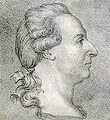Template:Selected anniversaries/April 18: Difference between revisions
No edit summary |
No edit summary |
||
| Line 1: | Line 1: | ||
<gallery> | <gallery> | ||
File:Johan Carl Wilcke.jpg|link=Johan Wilcke (nonfiction)|1796: Physicist [[Johan Wilcke (nonfiction)|Johan Carl Wilcke]] dies. Wilcke invented the electrophorus, and calculated the latent heat of ice. | File:Johan Carl Wilcke.jpg|link=Johan Wilcke (nonfiction)|1796: Physicist [[Johan Wilcke (nonfiction)|Johan Carl Wilcke]] dies. Wilcke invented the electrophorus, and calculated the latent heat of ice. | ||
File:Justus von Liebig circa 1866.jpg|link=Justus von Liebig (nonfiction)|1873: Chemist and academic [[Justus von Liebig (nonfiction)|Justus von Liebig]] dies. Von Liebeg made pioneering contributions to organic chemistry, especially agricultural and biological chemistry; he is known as the "Father of the fertilizer industry". | File:Justus von Liebig circa 1866.jpg|link=Justus von Liebig (nonfiction)|1873: Chemist and academic [[Justus von Liebig (nonfiction)|Justus von Liebig]] dies. Von Liebeg made pioneering contributions to organic chemistry, especially agricultural and biological chemistry; he is known as the "Father of the fertilizer industry". | ||
File:San Francisco 1906 earthquake Post-and-Grant-Avenue.jpg|link=1906 San Francisco earthquake (nonfiction)|1906: An [[1906 San Francisco earthquake (nonfiction)|earthquake and fire destroy much of San Francisco, California]]. | File:San Francisco 1906 earthquake Post-and-Grant-Avenue.jpg|link=1906 San Francisco earthquake (nonfiction)|1906: An [[1906 San Francisco earthquake (nonfiction)|earthquake and fire destroy much of San Francisco, California]]. | ||
File:Einstein drumming.jpg|link=Albert Einstein|1907: Jazz drummer and theoretical physicist [[Albert Einstein]] hosts an all-star benefit concert to raise money for the rebuilding of San Francisco. | File:Einstein drumming.jpg|link=Albert Einstein|1907: Jazz drummer and theoretical physicist [[Albert Einstein]] hosts an all-star benefit concert to raise money for the rebuilding of San Francisco. | ||
File:Albert Einstein 1921.jpg|link=Albert Einstein (nonfiction)|1955: Physicist, engineer, and academic [[Albert Einstein (nonfiction)|Albert Einstein]] dies. Einstein developed the theory of relativity, one of the two pillars of modern physics (alongside quantum mechanics). | File:Albert Einstein 1921.jpg|link=Albert Einstein (nonfiction)|1955: Physicist, engineer, and academic [[Albert Einstein (nonfiction)|Albert Einstein]] dies. Einstein developed the theory of relativity, one of the two pillars of modern physics (alongside quantum mechanics). | ||
File:Curt Meyer.jpg|link=Curt Meyer (nonfiction)|2011: Mathematician [[Curt Meyer (nonfiction)|Curt Meyer]] dies. Meyer made notable contributions to number theory, including an alternative solution to the class number 1 problem, building on the original Stark–Heegner theorem. | File:Curt Meyer.jpg|link=Curt Meyer (nonfiction)|2011: Mathematician [[Curt Meyer (nonfiction)|Curt Meyer]] dies. Meyer made notable contributions to number theory, including an alternative solution to the class number 1 problem, building on the original Stark–Heegner theorem. | ||
Latest revision as of 03:17, 18 April 2022
1796: Physicist Johan Carl Wilcke dies. Wilcke invented the electrophorus, and calculated the latent heat of ice.
1873: Chemist and academic Justus von Liebig dies. Von Liebeg made pioneering contributions to organic chemistry, especially agricultural and biological chemistry; he is known as the "Father of the fertilizer industry".
1907: Jazz drummer and theoretical physicist Albert Einstein hosts an all-star benefit concert to raise money for the rebuilding of San Francisco.
1955: Physicist, engineer, and academic Albert Einstein dies. Einstein developed the theory of relativity, one of the two pillars of modern physics (alongside quantum mechanics).
2011: Mathematician Curt Meyer dies. Meyer made notable contributions to number theory, including an alternative solution to the class number 1 problem, building on the original Stark–Heegner theorem.





